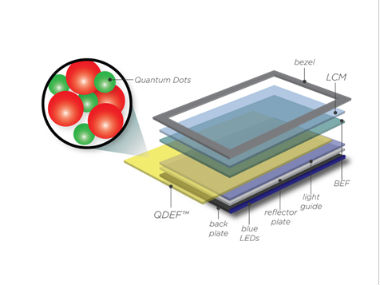In a feat comparable to the fable of blind man who carried a lame man on his back, lending him his feet and borrowing from him his eyes, researchers at the Indian Institute of Science (IISc) Bangalore have combined light emitting but poor conductor quantum dots with good conductor, but non-light emitting graphene to produce a novel hybrid that could revolutionize the next-gen mobile and television displays. [caption id=“attachment_4221383” align=“alignleft” width=“380”]  Quantum dot LED[/caption] **Quantum dot** semiconductor **nanocrystals** absorb Ultraviolet light and produce sharp, bright colours. But, they are poor electrical conductors. They are, therefore, are suitable to make devices that convert light into electricity. Graphene, on the other hand, is very thin two-dimensional material and are almost transparent to light. They emit radiation very faintly. But, they are excellent electrical conductors. When hybrids are formed by combining the two, normally energy generated from incident light in a quantum dot is swiftly pulled away and absorbed by graphene and converted into electrical signals. They can, therefore, be used to develop high efficiency and sensitive sensors or photo-detectors. However, what is good for photo-detectors is bad for fabrication of display devices. Graphene acts like a sponge inhibits quantum dots from emitting light by taking away the energy says senior author Jaydeep Kumar Basu, Professor, Department of Physics, IISc. Without emission of light, there is no display device. The researchers have surmounted the hurdle, eliminated the quenching effect and have fabricated a highly efficient and tunable hybrid material using a phenomenon called superradiance. If there are two swings attached to the same bar, swinging one makes the other to swing in harmony due to the coupling effect. In like manner usually when a set of atoms are excited each atom emits light independently. However, under certain circumstances, all the atoms of the quantum dots can be coaxed to cooperate and emit light in symphony. Called superradiance, this phenomenon can override the quenching effect to emit bright enough light from a hybrid quantum dot. In their earlier work, Prof. Basu’s team was able to bring about superradiance in a thin layer of quantum dots by combining it with metal nanoparticles under certain experimental conditions. However, an efficient quantum dot hybrid would require combination with graphene. In this work, they were able to show that when the individual quantum dots are 5 nm or less apart, and the quantum dot layer and graphene are separated by a distance of 3 nm or less, quantum dot-graphene hybrid exhibit superradiance. “We have shown for the first time that we are able to get away from this ‘sponge’ effect, and keep the emitters alive,” he says. With superradiance, the light emitted by the hybrid was three times higher than the simple quantum dots alone. Further, an advantage with graphene is that you can also tune it electrically. “You can vary the intensity by simply changing the voltage or the current.” Quantum dots are an ideal replacement for LEDs. A mere 2 to 10 nanometers in diameter, which is equivalent to 50 atoms, quantum dots are incredibly small. In other words, one can line up nearly 3 million quantum dots within the width of a human thumb. When light falls on this teeny weeny semiconductor quantum dots, valance electron are excited to the conduction band, leaving behind a hole. Usually, the excited electron returns to its ground state emitting the excess energy in the form of light. Remarkably, the colour of the emitted light depends upon the size of the quantum dot. If they are about 50 atoms size across they would glow in red, if 30 atoms in diameter, they will glow in green and even smaller one in blue. Combining these three basic colours we can have a range of brilliant hues. Quantum dots technology is expected to revolutionize the next-gen LCD screens in our phones, tablets, TVs and laptops and make them consume much less power and thereby increase the battery life significantly. Anyone who had tried to maximize the battery life in our mobile phone would have to first fiddle with the display settings. It is the screen that sucks most power. The potential power saving from a quantum dot based display device is estimated to be around 20 percent. In the normal LCD, white light is produced and the colours are obtained by using filters. However, as the quantum dots emit light in specific colours, we have very little wasted light and get a more-saturated, and more-accurate colour display. Funded by the nano-mission of the Department of Science and Technology, the researchers have for the first time successfully demonstrated fabrication of the hybrid material. They have published a report on their work in ACS Photonics Besides Prof. Basu, the research team included M. Praveena, T. Phanindra Sai, Riya Dutta and A. Ghosh from Department of Physics, Indian Institute of Science, Bangalore. India Science Wire
Quantum dot semiconductor nanocrystals absorb Ultraviolet light and produce sharp, bright colours.
Advertisement
End of Article


)



